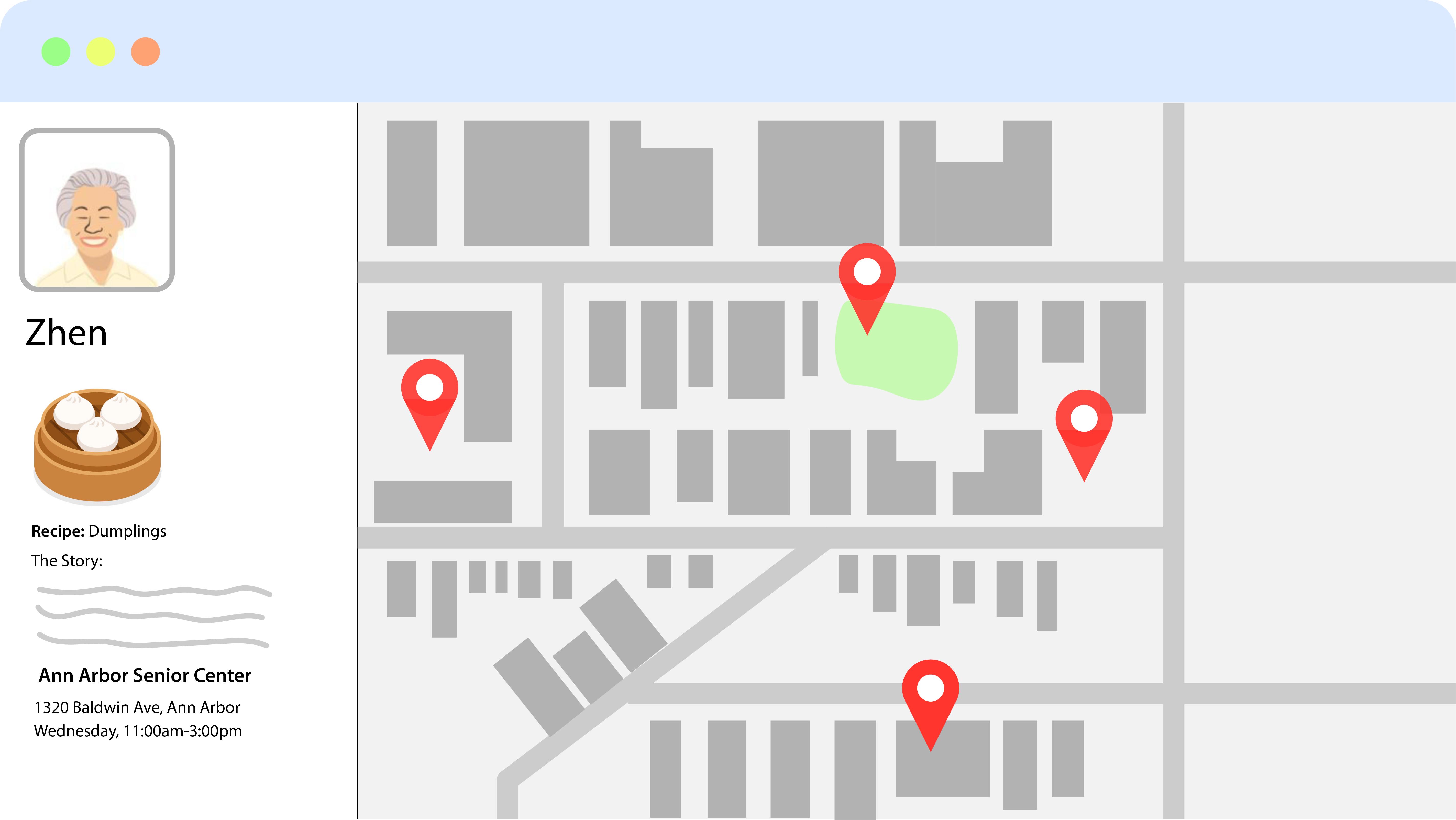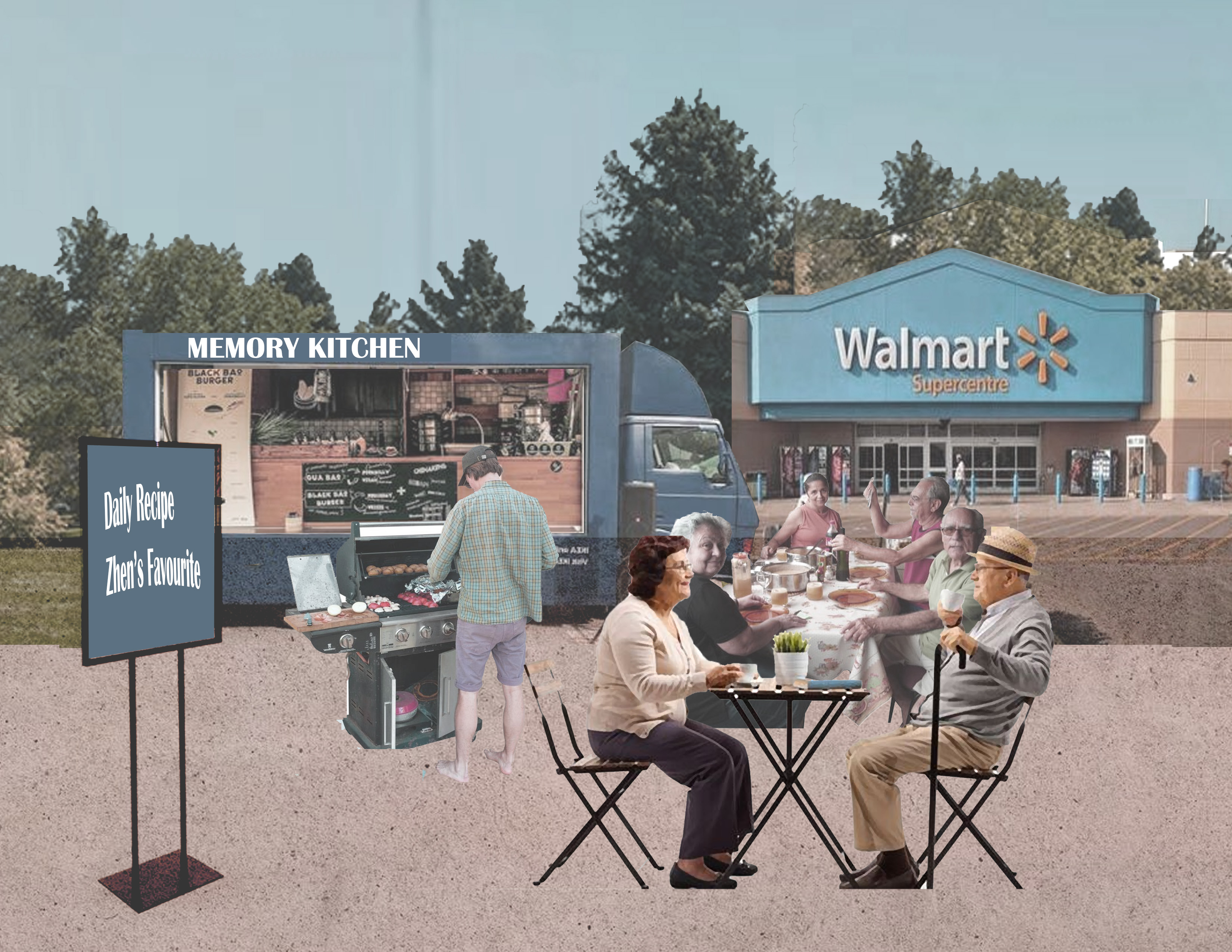︎ Memory Kitchen:
Improving the 6 pillars of Brain HealthThrough the collection of recipes and the memories behind them, engaging with the community
in a social and educational setting, and empowering senior residents we seek to strengthen the health of both body and mind for not only aging populations but communities as a whole.
By Natalie DeLiso︎, Jivitesh Chandnani ︎, Zhi Lin︎, Jagger Davis ︎

Who

This project was designed through the lens of a senior persona, Grandma Zhen, an 88-year-old woman who has recently immigrated from China. In addition to the difficulties of adjusting to a new place and culture
Persona Zhen

Zhen’s community network
Why
The act of cooking for and with others has been shown to improve cognitive health in older individuals, in addition to the benefits of a diversified diet of freshly prepared foods.
How
Our intervention begins with collecting specific recipes or dishes, as well as the memories behind them from residents within senior living facilities. Educational cooking events, led by the recipe provider with the help of staff members will be held at key points within the community, using a mobile component. This will be expanded to a Nationwide network creating a platform for the sharing of recipes and stories.
What
Recipes collected upon resident intake will be compiled into a physical and digital cookbook. These dishes will then be brought to the community using a mobile kitchen. These artifacts will preserve not only the recipes but also the residents who provided them and the memories that were made from them. The events themselves will be opportunities for social engagement and intergenerational interaction, through the teaching of recipes and cultural heritage. Our proposal used to reach this goal is broken into three parts: a NOW, NEAR, and FAR component.
Now.
The first design intervention, able to be implemented immediately, is focused on the senior living facility chosen for Zhen. It consists of a physical record of recipes provided by residents, as well as the memories behi
nd them that make them significant.


Near.
These recipes are then brought to the community using a mobile kitchen, where events, led by the recipe giver, are held to teach participants the recipes and share the stores and the food.


Far.
This system is expanded in to a nationwide scale, connecting with the families of the original recipe givers to create an ever-expanding network of shared histories


So What
Cooking has been shown to benefit mental health in older individuals through multiple avenues. The recollection of the recipes and the teaching of them engages the brain, as well as the social act of cooking with others as a preventative against depression. The physical act of cooking provides an additional means of exercise and a preventative measure against degenerative conditions like arthritis, and in addition to the balanced nutritional intake improves the quality of sleep. The mobile components of our proposal will also create opportunities for intergenerational connection within the community, reducing feelings of isolation, and providing a means for the sharing of cultural experiences.
Design To Outcomes
In this project, we have been asked to create opportunities for intergenerational Live, Work, and Play using an Enriched Environments framework to address the Six Pillars of Brain Health, as described by AARP: Manage Stress, Eat Right, Restorative Sleep, Ongoing Exercise, Be Social, and Engage Your Brain. The outcomes of our interventions meet our desired goal of the Six Pillars in the following ways:
The intergenerational connections made through the sharing of knowledge and engaged cooking activities provide improved socialization. The act of cooking provides great physical exercise. Improved cognitive health through revisiting memories and teaching others. Healthier eating habits by introducing old favorites and new recipes prepared using fresh ingredients. Processes to manage stress through cooking activities and engaging the senses. and Improved sleep with routine healthy foods and physical activity.

Design to Outcomes Graphic
Links to Follow:
︎︎︎Two Page Report
︎
Works Cited
2. Farmer, Nicole, et al. “Psychosocial benefits of cooking interventions: A systematic review.” Health Education & Behavior, vol. 45, no. 2, 2017, pp. 167–180, https://doi.org/10.1177/1090198117736352.
3. Lindberg, Linda. “The Six Pillars of Brain Health.” Virginia, 23 Nov. 2021, states.aarp.org/virginia/the-six-pillars-of-brain-health.
4. Pilarski, Hannah, and Mary Dumas. “Get Cooking! Top Tips for Older Adults Managing Arthritis Hand Pain.” The National Council on Aging, 9 Jan. 2021, www.ncoa.org/article/get-cooking-top-tips-for-older-adults-managing-arthritis-hand-pain.
5. Walsh, Lisa. “Cooking Benefits for Seniors.” Maplewood Senior Living, 23 Aug. 2022, www.maplewoodseniorliving.com/blog/how-cooking-benefits-seniors/.